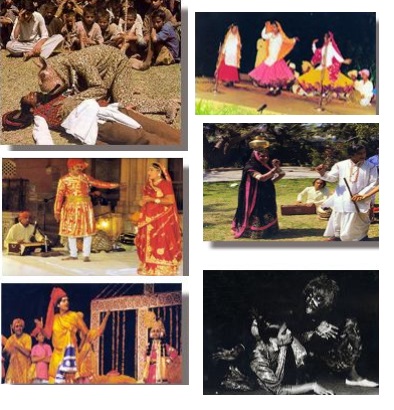NEW! The Gist (APR-24) | E-BOOKS |
General Knowledge for IAS Exams (PERFORMING ARTS OF INDIA)
General Knowledge for IAS Exams (PERFORMING ARTS OF INDIA)
DIFFERENT FORMS OF TRADITIONAL THEATRE
1. 1.BHAND PATHER(JASHIN) - KASHMIR
- unique combination of dance, music and acting.
- Satire, wit and parody are preferred for inducing laughter.
- music is provided with surnai, nagaara and dhol.
- Since the actors are mainly from the farming community, the impact of their way of living, ideals and sensitivity is noticable.
2. SWANG - HARYANA
- mainly music-based.
- Gradually, prose too, played its role in the dialogues.
- softness of emotions, accomplishment of rasa along with the development of character can be seen
- two important styles are from Rohtak and Haathras.
- In the style belonging to Rohtak, the language used is Haryanvi (Bangru) and in Haathras, it is Brajbhasha.
3. NAUTANKI - UTTAR PRADESH
- most popular centres - Kanpur, Lucknow and Haathras.
- The meters used in the verses are: Doha, Chaubola, Chhappai, Behar-etabeel.
- nowadays, women have also started taking part
4. RAASLEELA
- based exclusively on Lord Krishna legends
- believed that Nand Das wrote the initial plays based on the life of Krishna.
- dialogues in prose combined beautifully with songs and scenes from Krishna's pranks.
5. BHAVAI - GUJARAT
- Main centers of - Kutch and Kathiawar.
- instruments used are: bhungal, tabla, flute, pakhaawaj, rabaab, sarangi,manjeera, etc.
- there is a rare synthesis of devotional and romantic sentiments.
6. JATRA - BENGAL
- Fairs in honour of gods, or religious rituals and ceremonies have within their framework musical plays are known as Jatra.
- Krishna Jatra became popular due to Chaitanya prabhu's influence.
- earlier form of Jatra has been musical & dialogues were added at later stage.
- The actors themselves describe the change of scene, the place of action, etc.
7. BHAONA(ANKIA NAAT) - ASSAM.
- cultural glimpses of Assam, Bengal Orissa, Mathura and Brindavan can be seen.
- The Sutradhaar, or narrator begins the story, first in Sanskrit and then in either Brajboli or Assamese.
UPSC Exam Complete Study Materials
8. MAACH - MADHYA PRADESH
- Maach is used for the stage itself as also for the play.
- songs are given prominence in between the dialogues.
- The term for dialogue in this form is bol and rhyme in narration is termed vanag.
- The tunes of this theatre form are known as rangat.
9. TAMAASHA - MAHARASHTRA
- evolved from the folk forms such as Gondhal, Jagran and Kirtan.
- female actress is the chief exponent of dance movements in the play. She is known as Murki.
- Classical music, footwork at lightning-speed, and vivid gestures make it possible to portray all the emotions through dance.
10. DASHAVATAR - KONKAN AND GOA
- personify the ten incarnations of Lord Vishnu-the god of preservation and creativity. The ten incarnations are Matsya (fish), Kurma (tortoise),Varaha (boar), Narsimha (lion-man), Vaman (dwarf), Parashuram, Rama, Krishna (or Balram), Buddha and Kalki.
- Apart from stylized make-up, the Dashavatar performers wear masks of wood and papier mache.
11. KRISHNATTAM - KERALA
- came into existence in the middle of 17th century A.D. under the patronage of King Manavada of Calicut.
- Krishnattam is a cycle of eight plays performed for eight consecutive days.
- The plays are Avataram, Kaliamandana, Rasa krida, kamasavadha,Swayamvaram, Bana Yudham, Vivida Vadham, and Swargarohana.
- episodes are based on the theme of Lord Krishna - his birth, childhood pranks and various deeds depicting victory of good over evil.
12. MUDIYETTU - KERALA
- celebrated in the month of Vrischikam (November-December).performed only in the Kali temples of Kerala, as an oblation to the Goddess.
- depicts the triumph of goddess Bhadrakali over the asura Darika.
- seven characters in Mudiyettu-Shiva, Narada, Darika, Danavendra, Bhadrakali, Kooli and Koimbidar (Nandikeshvara) are all heavily made-up.
13. THEYYAM - KERALA
- 'Theyyam' derived from the Sanskrit word 'Daivam' meaning God.
- Hence it is called God's dance.
- performed by various castes to appease and worship spirits.
- distinguishing features - colourful costume and awe-inspiring headgears (mudi) nearly 5 to 6 feet high made of arecanut splices, bamboos, leaf sheaths of arecanut and wooden planks and dyed into different strong colours using turmeric, wax and arac.
14. KOODIYAATTAM - KERALA
- based on Sanskrit theatre traditions.
- characters of this theatre form are:
- Chakyaar or actor,
- Naambiyaar, the instrumentalists and
- Naangyaar, those taking on women's roles.
- The Sutradhar or narrator and the Vidushak or jesters are the protagonists.
- Vidushak alone delivers the dialogues.
- Emphasis on hand gestures and eye movements makes this dance and theatre form unique.
15. YAKSHAGAANA - KARNATAKA
- based on mythological stories and Puranas.
- most popular episodes are from the Mahabharata i.e. Draupadi swayamvar, Subhadra vivah, Abhimanyu vadh, Karna-Arjun yuddh and from Ramayana i.e. Raajyaabhishek, Lav-kush Yuddh, BaaliSugreeva yuddha and Panchavati.
16. THERUKOOTHU - TAMIL NADU
- literally means "street play".
- mostly performed at the time of annual temple festivals of Mariamman (Rain goddess) to achieve rich harvest.
- there is a cycle of eight plays based on the life of Draupadi.
- Kattiakaran, the Sutradhara gives the gist of the play to the audience
- Komali entertains the audience with his buffoonery.
17. KARYALA- HIMACHAL PRADESH
- deals with serious question of life & death briefly and with simplicity of expression & diction, all enveloped in humour.
- Indeed, audience is given essence of our cultural heritage of viewing the world as a stage and as an unsubstantial pageant which is to be negotiated and lived by rising above it.
- There is often stylistic diversity, which strengthens their identity from Swang, Nautanki, Bhagat, etc..


